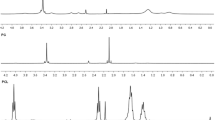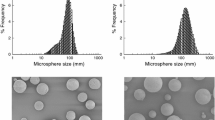Abstract
Thermoresponsive submicron-sized core–shell hydrogel particles with incorporated olive oil were synthesised and studied. The microspheres having poly(N-isopropylacrylamide-co-methyl methacrylate) core and poly(N-isopropylacrylamide) shell were synthesised by emulsifier-free seed polymerisation method. The morphology, particle size and distribution characteristics of the core microspheres were studied with different amount of initiator, monomer–solvent ratio and polymerisation time using scanning electron microscopy and dynamic light scattering particle size analysis. The prepared core and core–shell microspheres were regularly spherical with average size of around 190.0 and 320.0 nm respectively and nearly monodispersed size distribution. Transmission electron microscopy study revealed the core–shell structure of the microspheres. The thermoresponsive transition temperature (T t) of the core–shell microspheres was determined as 33 °C by optical absorbance measurement, dynamic light scattering particle size analysis and differential scanning calorimetry. The release rate of olive oil from core–shell microspheres was accelerated by squeezing out the entrapped olive oil as the temperature was increased above T t. Fourier transform infrared spectroscopy and nuclear magnetic resonance spectroscopy study indicated the formation of copolymer.












Similar content being viewed by others
References
Langer R, Peppas NA (2003) Advances in biomaterials, drug delivery and bionanotechnology. AIChE J 49:2990–3006
Oh JK, Drumright R, Siegwart DJ, Matyjaszewski K (2008) The development of microgel/nanogels for drug delivery applications. Prog Polym Sci 33:448–477
Kopecek J (1984) Controlled biodegradability of polymers—a key to drug delivery systems. Biomaterials 5:19–25
Roy I, Gupta MN (2003) Smart polymeric materials: emerging biochemical applications. Chem Biol 10:1161–1171
Hoffman AS (2002) Hydrogels for biomedical applications. Adv Drug Deliv Rev 43:1–12
Blanco-Andujar C, Tung LD, Thanh NTK (2010) Synthesis of nanoparticles for biomedical applications. Annu Rep Prog Chem Sect A 106:553–568
Lee LJ (2006) Polymer nanoengineering for biomedical applications. Ann Biomed Eng 34:75–88
Heris HK, Rahmat M, Mongeau L (2012) Characterization of a hierarchical network of hyaluronic acid/gelatin composite for use as a smart injectable biomaterial. Macromol Biosci 12:202–210
Abhinav P, Acharya JS, Lewis BGK (2013) Combinatorial co-encapsulation of hydrophobic molecules in poly(lactide-co-glycolide) microparticles. Biomaterials 34:3422–3430
Boehm AI, Martinon I, Zerrouk R, Rump E, Fessi H (2003) Nanoprecipitation technique for the encapsulation of agrochemical active ingredients. J Microencapsul 20:433–441
Devi N, Maji TK (2009) A novel microencapsulation of neem (Azadirachta Indica A.Juss.) seed oil (NSO) in polyelectrolyte complex of κ-carrageenan and chitosan. J Appl Polym Sci 113:1576–1583
Yosha I, Shani A, Magdassi S (2008) Slow release of pheromones to the atmosphere from gelatin-alginate beads. J Agric Food Chem 56:8045–8049
Marei AS, Soltan HR, Mousa A, Khamis A (2000) Leaching and mobility of carbofuran from granular and alginate controlled release formulations. J Agric Sci Camb 134:405–412
Prasertmanakit S, Praphairaksit N, Chiangthong W, Muangsin N (2009) Ethyl cellulose microcapsules for protecting and controlled release of folic acid. AAPS Pharm Sci Tech 10:1104–1112
Silva CM, Ribeiro AJ, Figueiredo M, Ferreira D, Veiga F (2006) Microencapsulation of hemoglobin in chitosan coated alginate microspheres prepared by emulsification/internal gelation. AAPS J 7:903–913
Peniche C, Fernandez M, Gallardo A, Lopez-Bravo A, Roman JS (2003) Drug delivery systems based on porous chitosan/polyacrylic acid microspheres. Macromol Biosci 3:540–545
Saravanan MK, Rao P (2010) Pectin–gelatin and alginate–gelatin complex coacervation for controlled drug delivery: influence of anionic polysaccharides and drugs being encapsulated on physicochemical properties of microcapsules. Carbohydr Polym 80:808–816
Vaida C, Mela P, Kunna K, Sternberg K, Keul H, Moller M (2010) Microparticles for drug delivery based on functional polycaprolactones with enhanced degradability: loading of hydrophilic and hydrophobic active compounds. Macromol Biosci 10:925–933
Filippousi M, Papadimitriou SA, Bikiaris DN, Pavlidou E, Angelakeris M, Zamboulis D et al (2013) Novel core–shell magnetic nanoparticles for taxol encapsulation in biodegradable and biocompatible block copolymers: preparation, characterization and release properties. Int J Pharm 448:221–230
Wickline SA, Lanza GM (2003) Nanotechnology for molecular imaging and targeted therapy. Circulation 107:1092–1095
Lee BZ, Wang LJ, Li D, Bhandari B, Li SJ, Lan Y et al (2009) Fabrication of starch-based microparticles by an emulsification crosslinking method. J Food Eng 92:250–254
Esposito E, Cervellati F, Menegatti E, Nastruzzi C, Cortesi R (2002) Spray dried eudragit microparticles as encapsulation devices for vitamin C. Int J Pharm 242:329–334
Weinbreck F, Nieuwenhuijse H, Robijn GW, Kriuf CGD (2004) Complexation of whey proteins with carrageenan. J Agric Food Chem 52:3550–3555
Kirby CJ, Whittle CJ, Rigby N, Coxon DT, Law BA (1991) Stabilization of ascorbic acid by microencapsulation in liposomes. Int J Food Sci Tech 26:437–449
Borm PJA, Kreyling W (2004) Toxicological hazards of inhaled nanoparticles—potential implications for drug delivery. J Nanosci Nanotechnol 4:1–11
Medina C, Santos-Martinez MJ, Radomski A, Corrigan OI, Rodomski MW (2007) Nanoparticles: pharmacological and toxicological significance. Br J Pharmacol 150:552–558
Na K, Jung J, Lee J, Hyun J (2010) Thermoresponsive pore structure of biopolymer microspheres for a smart drug carrier. Langmuir 26:11165–11169
Fundueanu G, Constantin M, Ascenzi P (2008) Preparation and characterization of pH- and temperature-sensitive pullulan microspheres for controlled release of drugs. Biomaterials 29:2767–2775
Wei H, Zhang X, Cheng C, Cheng SX, Zhuo RX (2007) Self-assembled, thermosensitive micelles of a star block copolymer based on PMMA and PNIPAAm for controlled drug delivery. Biomaterials 28:99–107
Kim JH, Lee SB, Kim SJ, Lee YM (2002) Rapid temperature/pH response of porous alginate-g-poly(N-isopropylacrylamide) hydrogels. Polymer 43:7549–7558
Huang X, Lowe TL (2005) Biodegradable thermoresponsive hydrogels for aqueous encapsulation and controlled release of hydrophilic model drugs. Biomacromolecules 6:2131–2139
Zhang XZ, Wu DO, Chu CC (2004) Synthesis, characterization and controlled drug release of thermosensitive IPN-PNIPAAm hydrogels. Biomaterials 25:3793–3805
Liu L, Sheardown H (2005) Glucose permeable poly(dimethyl siloxane) poly(N-isopropylacrylamide) interpenetrating networks as ophthalmic biomaterials. Biomaterials 26:233–244
Zhang Y, Yarin AL (2009) Stimuli-responsive copolymers of n-isopropyl acrylamide with enhanced longevity in water for micro- and nanofluidics, drug delivery and non-woven applications. J Mater Chem 19:4732–4739
Atkin R, Davies P, Hardy J, Vincent B (2004) Preparation of aqueous core/polymer shell microcapsules by internal phase separation. Macromolecules 37:7979–7985
Wei H, Zhang XZ, Zhou Y, Cheng SX, Zhuo RX (2006) Self-assembled thermoresponsive micelles of poly(N-isopropyl acrylamide-b-methyl methacrylate). Biomaterials 27:2028–2034
Komarova GA, Starodubtsev SG, Khokhlov AR (2009) Investigation of physical-chemical properties of agarose hydrogels with embedded emulsions. J Phys Chem B 113:14849–14853
Komarova GA, Starodubtsev SG, Lozinsky VL, Kalinina EV, Landfester K, Khokhlov AR (2008) Intelligent gels and cryogels with entrapped emulsions. Langmuir 24:4467–4469
Preetz C, Rübe A, Reiche I, Hause G, Mäder K (2008) Preparation and characterization of biocompatible oil-loaded polyelectrolyte nanocapsules. Nanomedicine:NBM 4:106–114
Kiritsakis A, Markakis P (1988) Olive oil: a review. Adv Food Res 31:453–482
Devi N, Hazarika D, Deka C, Kakati DK (2012) Study of complex coacervation of gelatin A and sodium alginate for microencapsulation of olive oil. J Macromol Sci Part A: Pure and Appl Chem 49:936–945
Sun-Waterhouse D, Zhou J, Miskelly GM, Wibisono R, Wadhwa SS (2011) Stability of encapsulated olive oil in the presence of caffeic acid. Food Chem 126:1049–1056
Assmann G, de Backer G, Bagnara S, Betteridge J, Crepaldi G, Fernandez AC (1997) International consensus statement on olive oil and the Mediterranean diet: implications for health in Europe. Eur J Cancer Prev 6:418–421
Owen RW, Giacosa A, Hull WE, Haubner R, Wurtele G, Spiegelhalder B et al (2000) Olive oil consumption and health: the possible role of antioxidants. Lancet Oncol 1:107–112
Ozyilkan O, Colak D, Akcali Z, Basturk B (2005) Olive: Fruit of peace against cancer. Asian Pac J Cancer Prev 6:77–82
Garcia-Gonzalez DLG, Aparicio R (2010) Research in olive oil: challenges for the near future. J Agric Food Chem 58:12569–12577
Xiao XC, Chu LY, Chen WM, Wang S, Xie R (2004) Preparation of submicrometer-sized monodispersed thermoresponsive core–shell hydrogel microspheres. Langmuir 20:5247–5253
Santos AM, Elaissari A, Martinho JMG, Pichot C (2005) Synthesis of cationic poly(methyl methacrylate)-poly(N-isopropyl acrylamide) core–shell latexes via two-stage emulsion copolymerization. Polymer 46:1181–1188
Zhang F, Wang CC (2008) Preparation of thermoresponsive core–shell polymeric microspheres and hollow NIPAM microgels. Colloid Polym Sci 286:889–895
Gao H, Yang W, Min K, Zha L, Wang C, Fu S (2005) Thermosensitive poly(N-isopropylacrylamide) nanocapsules with controlled permeability. Polymer 46:1087–1093
Prazeres T, Farinha JPS, Martinho JMG (2008) Control of oligonucleotide distribution on the shell of thermoresponsive polymer nanoparticles. J Phys Chem C 112:1633–1641
Pinheiro JP, Moura L, Fokkink R, Farinha JPS (2012) Preparation and characterization of low dispersity anionic multiresponsive core–shell polymer nanoparticles. Langmuir 28:5802–5809
Prazeres TJV, Santos AM, Martinho JMG (2004) Adsorption of oligonucleotides on PMMA/NIPAM core–shell latexes: polarity of the NIPAM shell probed by fluorescence. Langmiur 20:6834–6840
Zhu H, Tao J, Wang W, Zhou Y, Li P, Li Z et al (2013) Magnetic, fluorescent, and thermo-responsive Fe3O4/rare earth incorporated poly(St-NIPAM) core–shell colloidal nanoparticles in multimodal optical/magnetic resonance imaging probes. Biomaterials 34:2296–2306
Polozova A, Winnik FM (1999) Contribution of hydrogen bonding to the association of liposomes and an anionic hydrophobically modified poly(N-isopropylacrylamide). Langmuir 15:4222–4229
Koga S, Sasaki S, Maeda H (2001) Effect of hydrophobic substances on the volume phase transition of N-isopropylacrylamide gels. J Phys Chem B 105:4105–4110
Acknowledgements
The research has been sponsored by the University Grants Commission, New Delhi, India under the Dr. D.S. Kothari Post-Doctoral Fellowship Scheme. The author (N.D.) is grateful to UGC for financial assistance. The authors wish to thank SAIF, North-Eastern Hill University, Shillong for SEM and TEM analysis and UGC DAE CSR, Kolkata Centre for DLS analysis.
Author information
Authors and Affiliations
Corresponding author
Rights and permissions
About this article
Cite this article
Devi, N., Kakati, D.K. Thermoresponsive submicron-sized core–shell hydrogel particles with encapsulated olive oil. Colloid Polym Sci 292, 2581–2596 (2014). https://doi.org/10.1007/s00396-014-3309-6
Received:
Revised:
Accepted:
Published:
Issue Date:
DOI: https://doi.org/10.1007/s00396-014-3309-6




